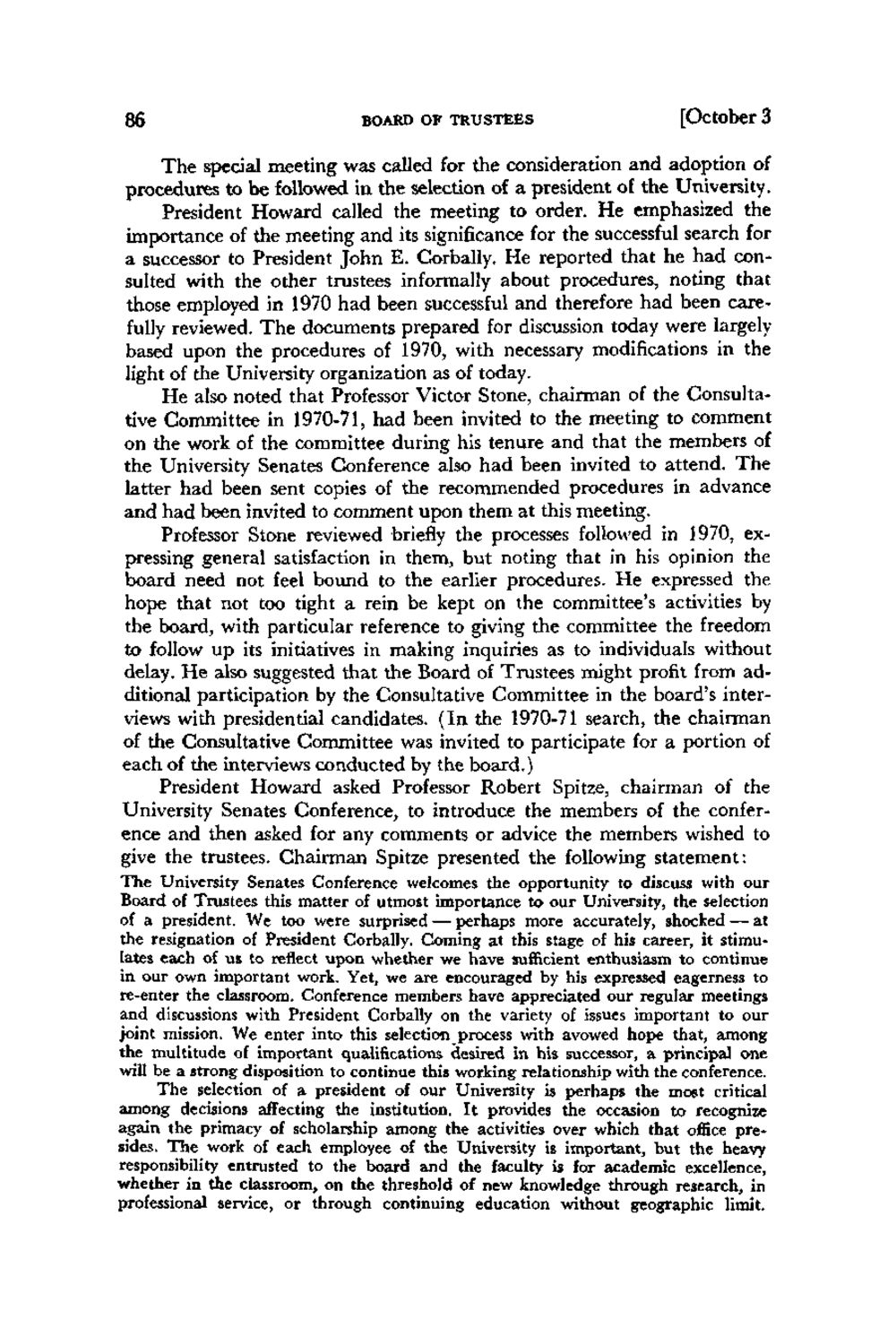| |
| |
Caption: Board of Trustees Minutes - 1980
This is a reduced-resolution page image for fast online browsing.

EXTRACTED TEXT FROM PAGE:
86 BOARD OF TRUSTEES [October 3 T h e special meeting was called for the consideration and adoption of procedures to be followed in the selection of a president of the University. President Howard called the meeting to order. He emphasized the importance of the meeting and its significance for the successful search for a successor to President John E. Corbally. He reported that he had consulted with the other trustees informally about procedures, noting that those employed in 1970 had been successful and therefore had been carefully reviewed. T h e documents prepared for discussion today were largely based upon the procedures of 1970, with necessary modifications in the light of the University organization as of today. H e also noted that Professor Victor Stone, chairman of the Consultative Committee in 1970-71, had been invited to the meeting to comment on the work of the committee during his tenure and that the members of the University Senates Conference also had been invited to attend. T h e latter had been sent copies of the recommended procedures in advance and had been invited to comment upon them at this meeting. Professor Stone reviewed briefly the processes followed in 1970, expressing general satisfaction in them, but noting that in his opinion the board need not feel bound to the earlier procedures. H e expressed the hope that not too tight a rein be kept on the committee's activities by the board, with particular reference to giving the committee the freedom to follow up its initiatives in making inquiries as to individuals without delay. H e also suggested that the Board of Trustees might profit from additional participation by the Consultative Committee in the board's interviews with presidential candidates. ( I n the 1970-71 search, the chairman of the Consultative Committee was invited to participate for a portion of each of the interviews conducted by the board.) President Howard asked Professor Robert Spitze, chairman of the University Senates Conference, to introduce the members of the conference and then asked for any comments or advice the members wished to give the trustees. Chairman Spitze presented the following statement: T h e University Senates Conference welcomes the opportunity to discuss with our Board of Trustees this matter of utmost importance to our University, the selection of a president. We too were surprised — perhaps more accurately, shocked — at the resignation of President Corbally. Coming at this stage of his career, it stimulates each of us to reflect upon whether we have sufficient enthusiasm to continue in our own important work. Yet, we are encouraged by his expressed eagerness to re-enter the classroom. Conference members have appreciated our regular meetings and discussions with President Corbally on the variety of issues important to our joint mission. We enter into this selection process with avowed hope that, among the multitude of important qualifications desired in his successor, a principal one will be a strong disposition to continue this working relationship with the conference. The selection of a president of our University is perhaps the most critical among decisions affecting the institution. It provides the occasion to recognize again the primacy of scholarship among the activities over which that office presides. The work of each employee of the University is important, but the heavy responsibility entrusted to the board and the faculty is for academic excellence, whether in the classroom, on the threshold of new knowledge through research, in professional service, or through continuing education without geographic limit.
| |